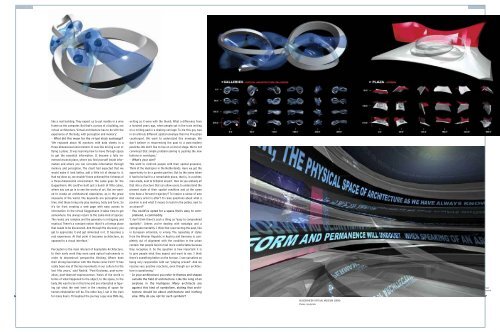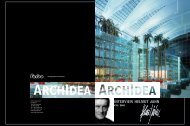Download as PDF - ArchIdea
Download as PDF - ArchIdea
Download as PDF - ArchIdea
You also want an ePaper? Increase the reach of your titles
YUMPU automatically turns print PDFs into web optimized ePapers that Google loves.
6<br />
like a real building. They expect us to put marble in a wire<br />
frame on the computer. But that’s a proxy of a building, not<br />
virtual architecture. Virtual architecture h<strong>as</strong> to do with the<br />
experience of the body, with perception and memory.’<br />
-What did this mean for the virtual stock exchange?<br />
‘We replaced about 40 monitors with data sheets in a<br />
three-dimensional environment. It w<strong>as</strong> like driving a car or<br />
flying a plane. It w<strong>as</strong> learning how to move through space<br />
to get the essential information. It became a fully immersed<br />
visceral place, where you find yourself inside information<br />
and where you can correlate information through<br />
memory and perception. The client had expected that we<br />
would make it look better, add a little bit of design to it.<br />
Had we done so, we wouldn’t have achieved the richness of<br />
a three-dimensional environment. The same goes for the<br />
Guggenheim. We could’ve built just a bunch of little cubes,<br />
where you can go in to see the works of art. But we wanted<br />
to create an architectural experience, <strong>as</strong> in the great<br />
museums of the world. The keywords are perception and<br />
time. And these bring into play memory, body and form. So<br />
it’s far from creating a web page with e<strong>as</strong>y access to<br />
information. In the virtual Guggenheim it takes time to get<br />
somewhere. You always return to the same kind of spaces.<br />
The rooms are complex and the geometry is intriguing and<br />
mystical. There’s a constant notion that it’s a foreign place<br />
that needs to be discovered. And through the discovery you<br />
get to appreciate it and get immersed in it. It becomes a<br />
real experience. At that point it becomes architecture, <strong>as</strong><br />
opposed to a visual interface.’<br />
Perception is the main interest of Asymptote Architecture.<br />
In their early work they even used optical instruments in<br />
order to deconstruct perspective thinking. Where does<br />
their strong f<strong>as</strong>cination with this theme come from? ‘It h<strong>as</strong><br />
really been one of the key movements in our culture for the<br />
l<strong>as</strong>t fifty years,’ said R<strong>as</strong>hid. ‘Post-Duchamp, post-surrealism,<br />
post-abstract-expressionism. Views of the world in<br />
terms of what happened to the object, to the space, to the<br />
body. We want to be in this time and are interested in figuring<br />
out what the next level in the creating of space for<br />
human inhabitation will be. The other day, I sat in the train<br />
for many hours. Throughout the journey a guy w<strong>as</strong> SMS-ing,<br />
writing <strong>as</strong> it were with the thumb. What a difference from<br />
a hundred years ago, when people sat in the train writing<br />
on a writing pad in a shaking carriage. To me this guy w<strong>as</strong><br />
in an entirely different spatial envelope than his Proustian<br />
counterpart. We want to understand this envelope. We<br />
don’t believe in resurrecting the p<strong>as</strong>t to a post-modern<br />
p<strong>as</strong>tiche. We don’t like to live on a kind of stage. We’re not<br />
convinced that simple problem-solving is pushing the new<br />
buttons or envelopes.’<br />
-What’s your aim?<br />
‘We want to confront people with their spatial presence.<br />
Think of the Hydrapier in the Netherlands. Here we got the<br />
opportunity to do a garden pavilion. But by the same token<br />
it had to be built in a remarkable place, that is, in a polder,<br />
man-made, next to Schiphol airport. How do you embody all<br />
that into a structure that can allow users to understand the<br />
present state of their spatial condition and at the same<br />
time have a forward trajectory? To inspire a sense of awe<br />
that every artist is after? To raise questions about what a<br />
pavilion is and what it means to build in the polder, next to<br />
an airport?’<br />
-You could’ve opted for a space that’s e<strong>as</strong>y to comprehend,<br />
a commodity.<br />
‘I don’t think there’s such a thing <strong>as</strong> "e<strong>as</strong>y to comprehend<br />
spatiality". Unless you’re dealing with nostalgia and a<br />
retrograde mentality. I think that resurrecting the p<strong>as</strong>t, like<br />
in European urbanism, is wrong. The repeating of styles<br />
from the Weimar Republic in Austria and Germany is completely<br />
out of alignment with the condition in the urban<br />
context. But people tend to feel more comfortable because<br />
they recognise it. So the question is how important it is<br />
to give people what they expect and want to see. I think<br />
there’s something better on the horizon. I see ourselves <strong>as</strong><br />
being very responsible with our "playing around". And we<br />
receive very positive reactions, even though our architecture<br />
is questioning.’<br />
- In your architecture you refer to themes and shapes<br />
outside the field of architecture. Like the wing of an<br />
airplane in the Hydrapier. Many architects are<br />
against this kind of symbolism, stating that architecture<br />
should be about architecture and nothing<br />
else. Why do you opt for such symbols?<br />
GUGGENHEIM VIRTUAL MUSEUM (2000)<br />
Photos: Asymptote<br />
Hani<br />
R<strong>as</strong>hid<br />
7



